Max Simmons
Guru
- Joined
- Oct 15, 2007
- Messages
- 805
- Vessel Make
- Ocean Alexander 38'
First off, Electrical issues are my least favorite problem to deal with on the boat.
Over last weekend, on the hook for 3 days I ran into an issue with the inverter. When not on shore power, we use the inverter intermittently to run the refer and charge electrical devices.
Friday, all was good. inverter worked fine, no issues. Saturday, ran the genset in the morning to charge the house batteries (2-8D's), panel showd them fully charged after about an hour, which is normal. Later, switched on inverter and nothing. The battery switch at the panel can be turned to 1, 2, both or off.
I normally leave it in the both position. I switched to battery 1, meter shows a little over 12 volts, switch to #2 and meter shows 0. Since the #2 battery is around 7 years old, I figure that it is shot, so pulled it out (fun!) planning to replace it. Just stopped by the battery store, they check it and say it's fine. It's at about 85% charge and cells all look good.
I checked corrosion on all the terminals and connection points and all look good.
Suggestions on what to check next? Was planning on getting out this weekend and this has put a crimp in our plans.
The inverter/charger is a Xantrex Freedom 20 and never a hick-up.
Over last weekend, on the hook for 3 days I ran into an issue with the inverter. When not on shore power, we use the inverter intermittently to run the refer and charge electrical devices.
Friday, all was good. inverter worked fine, no issues. Saturday, ran the genset in the morning to charge the house batteries (2-8D's), panel showd them fully charged after about an hour, which is normal. Later, switched on inverter and nothing. The battery switch at the panel can be turned to 1, 2, both or off.
I normally leave it in the both position. I switched to battery 1, meter shows a little over 12 volts, switch to #2 and meter shows 0. Since the #2 battery is around 7 years old, I figure that it is shot, so pulled it out (fun!) planning to replace it. Just stopped by the battery store, they check it and say it's fine. It's at about 85% charge and cells all look good.
I checked corrosion on all the terminals and connection points and all look good.
Suggestions on what to check next? Was planning on getting out this weekend and this has put a crimp in our plans.
The inverter/charger is a Xantrex Freedom 20 and never a hick-up.

